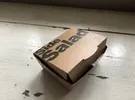A new life cycle analysis report has highlighted the environmental credentials of cartonboard packaging when compared against fossil-based alternatives.
 Published in June 2021, 'Cartonboard Life Cycle; Comparing the carbon footprint of carton packaging against alternative solutions', goes into the granular detail of the cradle-to-grave environmental performance of cartonboard in frozen food, ready meal, fast food and small electricals packaging, compared to other commonly-used packaging materials, such as multilaminate film bags, PP trays, PET trays and PVC blister packs.
Published in June 2021, 'Cartonboard Life Cycle; Comparing the carbon footprint of carton packaging against alternative solutions', goes into the granular detail of the cradle-to-grave environmental performance of cartonboard in frozen food, ready meal, fast food and small electricals packaging, compared to other commonly-used packaging materials, such as multilaminate film bags, PP trays, PET trays and PVC blister packs.
The study, carried out by RISE (Research Institutes of Sweden) Bioeconomy unit for Pro Carton, the European Association for Carton and Cartonboard Manufacturers, and peer reviewed by Intertek, provides an insight into the relative carbon footprints for packaging in different consumer sectors, alongside detailed explanations of the factors driving those comparative results.
RISE’s cradle-to-grave comparison ensures that the entire lifecycle of packaging is taken into account – from how it is produced (or grown in the case of the wood used in cartonboard manufacture) to processing and disposal. The study reports both fossil green-house-gas (GHG) emissions and biogenic GHG emissions and removals.
Fossil GHG emissions arise from non-renewable sources such as fossil fuels, while Biogenic emissions arise from the combustion of biofuels and the degradation of bio-based products. Biogenic removals refer to CO2 uptake from the atmosphere through photosynthesis during biomass growth.
Pro Carton General Manager Tony Hitchin commented: “Whilst the unique aspects of the life-cycle of fibre-based packaging are taken into account when calculating the total carbon footprint we also wanted to see what the results would be when only the fossil green-house-gas (GHG) emissions were considered and the cartonboard solutions gave a favourable result.”
Commenting on the results, Pro Carton’s Hitchin said: “The figures in this table clearly show that the predominantly cartonboard packaging consistently scores better than the alternatives when considering the impact per 1,000 units. Cartonboard clearly offers a protective, convenient, and customer-friendly alternative to conventional fossil-based packs.
“We know from other research that consumers have an overwhelming preference for cartonboard packaging over plastic, 8 to 1 preferred cartonboard/cardboard in our recent study amongst 7,000 consumers, and this report further supports the merits of changing to cartonboard packaging.”
The research compared the cradle-to grave carbon footprint of the complete packaging solution rather than just comparing the materials on a per tonne basis. Hitchin added: “It’s known that the carbon impact per tonne of material is much lower for cartonboard than polymers regardless of whether you look just at fossil emissions or also take the biogenic emissions and removals into consideration. We wanted to compare products on a per unit basis too as cartonboard packaging may not weigh the same as a fossil-based solution. Furthermore, the conversion and end-of-life impacts for each of the solutions will be different.”
For the full report, please click here.
For more information:
Pro Carton
www.procarton.com
